Do you have a question about the Panasonic AG-AF100P and is the answer not in the manual?
Identifies the specific camera model AG-AF100P.
Details basic operations of the camera recorder.
Warnings against opening the unit, exposure to rain, liquids, and heat.
Precautions for battery replacement, handling, and avoiding misuse.
Information regarding FCC rules and Canadian ICES-003 standards.
Notes on copyright laws and battery recycling procedures.
Instructions on water avoidance, ventilation, cord protection, and accessory use.
Guidelines for when servicing is required and general equipment care.
Advises using genuine Panasonic batteries to avoid safety risks.
Details on registering for an extended warranty repair program.
Outlines the process of recording to and playing back from SD/SDHC/SDXC cards.
Explains connecting the camera to a computer via USB for data transfer.
Information on Micro Four Thirds and Four Thirds lens mounts.
Details compatibility of specific Panasonic lenses with the camera.
Step-by-step guide for securely mounting a lens onto the camera body.
Instruction to remove the lens cap before recording.
Procedure for safely removing a lens from the camera mount.
How to activate or deactivate Image Stabilization on compatible lenses.
Lists compatible SD, SDHC, and SDXC memory cards and their capacities.
Specifies required file systems (FAT12, FAT16, FAT32, exFAT) for cards.
Explains the meaning of SD Speed Class 4 for stable recording.
Guidelines on avoiding dirt, liquids, and extreme environmental conditions for cards.
Precautions against water, magnetic fields, radio transmitters, and dust.
Guidelines for battery use, care, disposal, and avoiding physical damage.
Instructions for completely erasing data before discarding or transferring cards.
Information on display burn-in, pixel behavior, and condensation.
Importance of trial shots, calendar settings, and respecting copyright laws.
Instructions for attaching the camera to a tripod using mounting holes.
Explains how the manual is organized and references to other pages.
Lists trademarks, logos, and licensing details for product components.
Defines AVCHD as a high-definition video recording standard.
Notes on playback compatibility of recorded video with different equipment.
Lists all accessories provided with the camera.
Lists additional accessories available for separate purchase.
Identifies buttons, dials, and lamps on the left side of the camera.
Details input/output terminals and other connectors on the left side.
Identifies buttons, card slots, and accessories attachment points on the right side.
Details various output terminals and remote control jacks on the rear.
Identifies buttons and sensors on the front of the camera.
Details controls, sensors, and mounting points on the front-left area.
Steps for powering the camera on and off, and understanding the mode lamp.
How to enable and use the remote control, and its operational range.
How to activate the tally lamp for recording indication.
Explains the meanings of different tally lamp flashing patterns.
Guide for attaching the eye cup to the viewfinder for comfortable use.
Instructions for adjusting the viewfinder's angle and diopter.
How to open, position, and use the camera's LCD monitor.
Using the EVF DTL function to aid manual focusing.
Customizing viewfinder display parameters like brightness and contrast.
Customizing LCD monitor display parameters like brightness and contrast.
How to adjust the brightness of the LCD monitor backlight.
Procedure for setting the camera's time zone for accurate recording data.
Step-by-step guide to set the date and time on the camera.
Initial steps to prepare the camera for recording, including card insertion.
How to use the REC CHECK function to review recently recorded clips.
Explains the function and states of the SD memory card access lamp.
Procedure for formatting SD memory cards on the camera for optimal use.
Table showing estimated recording times for various card sizes and modes.
Notes on recording times and conditions for Variable Frame Rate (VFR) recording.
Step-by-step guide to safely remove an SD memory card from the camera.
Procedures for repairing card errors and using write-protection.
How to use the focus ring for manual focusing.
Using the PUSH AUTO button for temporary autofocus.
Utilizing focus assist tools to improve manual focusing accuracy.
How to manually control the lens aperture using the IRIS dial.
How to adjust the gain setting to brighten dark images.
Using the ND dial to control light intensity via built-in filters.
How to manually set white balance for accurate color reproduction.
Step-by-step guide for manual white balance adjustment.
Utilizing preset white balance values for quick adjustments.
Procedure for adjusting black balance for accurate color reproduction.
Using ATW for automatic, continuous white balance adjustment during recording.
Overview of the menu system and how to navigate it.
Steps for selecting, adjusting, and confirming menu settings.
Resetting user-defined settings to factory defaults.
Restoring individual scene files to their factory default settings.
Overview of settings within Scene File and SW Mode menus.
Details of settings found in Recording Setup and TC/UB Setup menus.
Options for display customization and SD card management.
Explores various other functions and playback setup options.
Details on voltage, power consumption, weight, and dimensions.
Information on pickup device, pixels, image size, and lens mount.
Specifications for recording formats, media, and VFR.
Details on SDI, HDMI, VIDEO outputs, and audio formats.
Specifications for microphone, audio outputs, and various terminals.
Details for the AC adaptor, LCD, and viewfinder specifications.

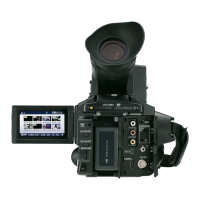
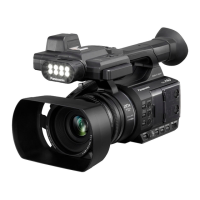
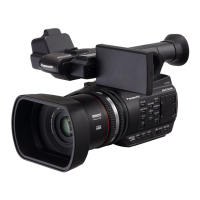
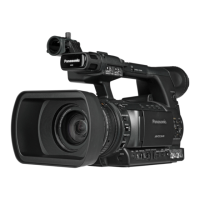
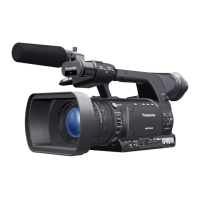
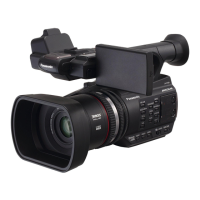




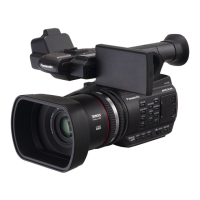
